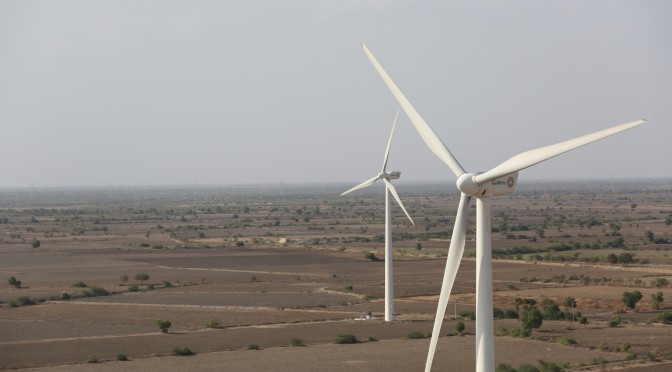India is the world’s fourth-largest onshore wind market by installations, with 37.5 GW of capacity as of 2019. Technical potential at 120-metre hub height is a whopping 695 GW, according the National Institute of Wind Energy, and the government has set a wind capacity target of 60 GW by 2022 and 140 GW by 2030. Wind is already the second most competitive energy source on India’s grid.
However, project installation has been decelerating recently, with only 2.3 GW installed in 2019. That is around half of the 4.1 GW of volume installed in 2017, and reflects slow execution when held against the 12 GW of capacity awarded in central and state tenders since 2017.
The India wind sector and installations have been traditionally erratic in nature and highly sensitive to policy changes. After the introduction of central auctions which transformed the wind procurement mechanism in the country, the market entered a state of limbo. Infrastructure was not ready to facilitate the capacity auctioned via central auctions. And states – the traditional wind procurement channel in India – took an extremely reclusive approach to create new demand. This resulted in declining installations from 2018-2020.
The market continues to be a bag of juxtapositions towards 2022, MEC+ and GWEC’s latest report, “India wind outlook towards 2022: Looking beyond headwinds”, analyses the factors which have led to a drag on market growth for India’s wind energy industry over the past two years, and provides an assessment on the forecast along with a pathway to overcome these challenges to realise the high potential of the market.

The key characteristics of the wind market today in India are:
- The Market Will Be Inherently Large and Lumpy in Installation The India wind market has conventionally had fluctuating capacity additions, being highly sensitive to policy changes. Nearly 13 GW is expected to be installed (pre-COVID-19) in the next three years; however, deployment will be unevenly distributed across years, geographies and the market mechanism. New capacity will be majorly concentrated in 2022, in two states and in central tenders.
- Demand Is Strong and Economics Support Wind Capacity India has aggressive targets for wind capacity: 60 GW in 2022 and 140 GW in 2030. The demand for wind originates from non-RPO compliance by state DISCOMs. Nearly ~20 GW of demand exists in the market in terms of unfulfilled non-solar RPOs towards 2022. Economically, as well, wind auction bid prices are 30-40% lower than the average pooled power procurement cost (APPC) for the majority of states in India. Hence, demand and price are the fundamental drivers of wind support in India.
- Activity Is Muted in the Market The government has successfully awarded nearly 12 GW of wind capacity through competitive auctions; however, the level of activity has been declining in the past year. While the tenders in 2017 and 2018 were over-subscribed, the tenders in 2019 have faced a lack of interest from the supply side. Several factors have led to the decline in activity including issues in grid and land availability, payment delays for RE projects and a slowdown in the signing of power supply agreements. Furthermore, pricing expectations have remained aggressive. The half-hearted attempts of state markets to revive demand and conduct auctions have largely been unsuccessful.
- Current Orders Are Over 8 GW in Project Pipeline Despite low uptake in the latest auctions, nearly 8.6 GW of active orders can be seen in India. The majority of the orders are from the 8-9 central auctions conducted between 2017-2019, while states contribute less than 11% of the active orders, given the low auctioning activity. Out of 8.6 GW, 3 GW is scheduled for commissioning in 2020, 5.2 GW in 2021 and 0.4 GW in 2022.
- Issues Choking Actualization of Existing and Creation of New Pipeline Delay in the availability of land, grid evacuation and issues in timely payments continue to drag on the existing wind pipeline, impacting scheduled dates of commissioning. The inhibitors combined with weak balance sheets of the developers will expose cracks in the deployment capabilities. While some capacity is already cancelled, more capacity is severely delayed and at risk of cancellation. The bottlenecks primarily shape up the capacity additions between 2020-2022.
- Government Is Actively Resolving Issues The government has taken a mix of reactive and proactive steps to resolve the issues in land, grid and payment delays. Understanding the impact of infrastructure bottlenecks in the market, the government has removed the pricing caps in the latest wind tender to provide developers with the flexibility of bidding and reboot interest. Payment guarantees are being created for short, medium and long-term defaults to promote investor confidence. The government is also planning a 25 GW plug-and-play wind park for wind capacity to resolve issues of land and grid and provide long-term volume visibility.
- However, Growth Will Be Lopsided The government resolutions comes in a little late, as the outcome of projects scheduled for commissioning in 2020 and 2021 has been largely decided. These projects will be impacted by the fault-lines that started emerging in 2017 around grid, land, aggressive pricing, financing and sales agreements. The capacity addition in the next three years will be uneven, with the market scaling towards 2022 and capacity deployment happening whenever and wherever these bottlenecks are eased or resolved. Total cumulative installations are expected to reach 50 GW in the base case and 54 GW in best case.

If you missed the India Wind Outlook Towards 2022: Report Launch & Roundtable, do view it here on GWEC’s Youtube Channel.


